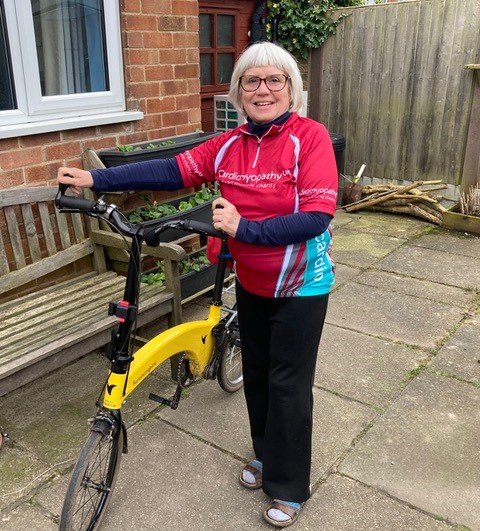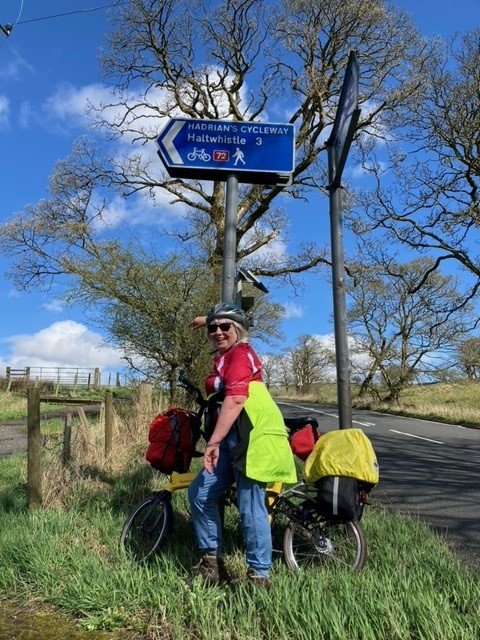Earlier this year, Sue took on the 73-mile Hadrian's Wall cycling challenge, raising £640 for Cardiomyopathy UK! Sue has shared her cardiomyopathy journey with us, from her diagnosis to now living with cardiomyopathy.
The Diagnosis

When I was 34, I had a sharp pain in my chest, followed by breathing problems which were diagnosed as asthma. I had the same pain in 2019, but this time the breathlessness was considerably worse. I went to my local A&E department and GP, who agreed with the initial diagnosis of asthma.
I was admitted into an intensive care unit (ICU) in March 2021 with left bundle branch block, where they found heart failure with reduced ejection fraction (EF), which they presumed was secondary to a heart attack. My current diagnosis is dilated cardiomyopathy (DCM). Further investigations ruled out any other conditions, and genetic screening showed no genetic indicators for cardiomyopathy, so we still don’t know why I developed DCM.
I have been able to manage my condition with the help of medication and a CRT-D that was inserted in November 2021. At my pacemaker clinic appointment in January 2023, I informed my clinicians that I had resumed cycling and had managed to increase my walking distance up to 6 miles. At the time I was exercising on alternate days, making sure to take a rest day in between. They were delighted and informed me that the main principle of giving me a heart device is to enable me to lead a normal life and do the things I enjoy doing. During this appointment they adjusted my CRT-D settings as they were wondering if I was having intermittent ventricular tachycardia (fast heart beats).
Taking on Hadrian’s Wall

Following my discharge from hospital, and recovery from my CRT-D implantation, I attended a 12-week cardiac rehabilitation programme at the hospital. I was then referred to the level three cardiac rehabilitation at my local leisure centre. Once I finished 12 weeks of level three rehabilitation, I was discharged to normal public leisure services. I used the gym at the leisure centre for about six months, but I found gyms boring, repetitive and with the weather improving I really wanted to be outside.
I have always been physically active by walking, cycling, yoga plus occasional swimming. Since my Pacing Clinic appointment in January 2023 I was able to increase my exercise tolerance level.
I have to listen to my body, and I have learnt to accept that I have good moments and not so good moments. I go at my own pace, and I am not bothered if I am further behind when I am out walking with my partner. I use hiking poles when I am out for a distance walk and have done since 2021. When I start to feel breathless, I use the hiking poles for an extra push, particularly when going up hills.
I wear a smart watch to monitor my heart rate when I'm exercising. If I start to feel breathless, I will switch on the heart monitor and aim to keep my heart rate around 120. When my heart rate does go over 120, I will stop, rest, and wait for my heart and breathing rate to settle down before continuing.
In February 2023, an advert caught my eye about walking along Hadrian’s Wall with a company who provide organised group holidays. I am not able to keep up with other people’s walking levels and I find it difficult to keep exercising at a consistent level, so I knew that I wouldn’t be able to join the group holiday. I kept re-visiting the Hadrian’s Wall holiday website, wishing I could do it but knowing full well I wouldn’t be able to keep up with a group. In June 2023, I decided that if I couldn’t do the walking holiday with a group, I would try to do it at my own pace.
I had toured Europe on a bicycle many years ago and based on this experience, I decided I would explore the possibility of walking and cycling Hadrian’s Wall. I planned out my trip using the national cycle route and booked B&Bs at manageable intervals. I planned to take my folding e-bike so that if I got too tired, I could catch a bus, train, or a taxi to my next B&B, and if my pacing clinic phoned me to advise me to go to the nearest hospital then I could use public transport. I continued with my training to try to improve my exercise tolerance level. I will never forget the day I rode the Tissington Trail in 2 hours covering about 15 miles. I loved every minute of this ride, and I knew on this day that Hadrian’s Wall was within my reach.
In November 2023, I attended my pacing clinic appointment to have an update done to my device. I gave them the date I rode the Tissington trail and informed them of some odd symptoms I had and what my watch recorded my heart rate at. They managed to find the trace of that date and informed me there was no abnormal rhythm and the increased heart rate was normal for exercise. I informed them of my plan to ride and walk Hadrian’s Wall and asked for advice about what I could let my heart rate go up to safely. They told me that because I am good at listening to my body and took appropriate action when I experienced some odd symptoms, I could let my heart rate go up to 150. They were very positive about what I was doing and planning.
I kept slowly increasing the distance I was riding and walking and on 4 April 2024, I was on the National Cycle Route 72 in Bowness on Solway, ready to start the most challenging ride I have ever undertaken. I completed the 73-mile route in seven days with one rest day.
I will never forget the day I reached Housesteads Fort at the highest point of the route - 260 meters. I burst into tears on my arrival, which concerned the lady greeting me. I told her that reaching Housesteads yesterday was only a dream and today is the reality.
Living with cardiomyopathy
I know many people with my condition have a really tough time living with cardiomyopathy, and that I am incredibly lucky to be as well as I am. My condition is managed well with medication, and I have had a good response to my CRT-D. I admit at times it has been really hard to keep a positive mindset, but I will continue to ride and walk for as long as I am able to do so.
I hope that I can provide hope to other people. I know from my own experience that cardiomyopathy can feel like a never-ending cycle of one step forwards, three steps back. I also hope that my story will encourage people to enjoy each moment of their small achievements as these, in time, can become big ones.
As I ride and walk, I often talk to people and raise awareness about cardiomyopathy. I have been surprised as to how many people disclosed their own heart problems to me, or know of someone who has a heart problem.
I have educated myself about my condition and I’m aware of the limitations it presents. I continue to ask questions from health professionals, both at my own health appointments and during support group meetings. During an online support group meeting in June 2024, the doctor described a research project in which they found by fine tuning people’s heart devices to work as well as possible with the individual’s own heart, that their quality of life improves. I owe a debt of gratitude to my own pacing clinic enabling me to improve the quality of my live but I also strongly believe that the more I know and understand about my condition, the more I can help myself.
Whether it is through volunteering, fundraising or raising awareness, you can help us change and improve the lives of those affected by cardiomyopathy.